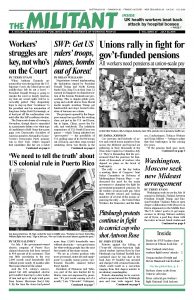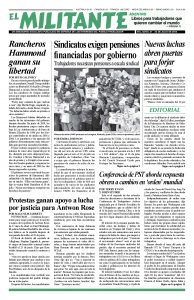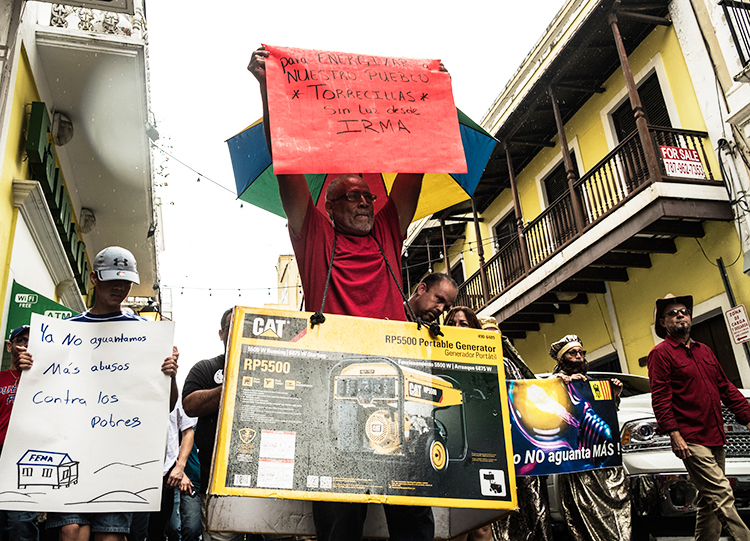On July 3 the government-owned electric company of Puerto Rico claimed electricity had been restored to 99.9 percent of its customers. That was little consolation to the over 2,000 mostly rural households still without power nearly 10 months after Hurricane Maria hit the island.
And the U.S. colony’s semi-repaired but still antiquated electric grid couldn’t stand up to a few inches of rain and up to 40 mph wind gusts from former Hurricane Beryl July 9. By the time the storm had passed more than 15,000 households were without electricity — not a good omen for what working people face the next few months of hurricane season.
“We are in a better position with more personnel, materials and equipment” to rapidly restore power, Gov. Ricardo Rosselló claimed before Beryl landed.
Residents of Humacao and Yabucoa, part of the area hardest hit by Maria, were not impressed by promises. “It’s just words coming out of a mouth,” Luis “Cheverito” Velázquez, a school janitor and fisherman in Humacao, said by phone July 10. Militant editor John Studer and correspondent Martín Koppel met Velázquez when they visited Humacao and Yabucoa at the end of May. More homes have electricity now, Lenis Rodríguez, a leader of the Yabucoa Support Group, told the Militant by phone. “But there are still pockets without electricity. There’s blackouts. There are hundreds of homes here that only have a tarp as a roof. The highways are full of potholes. And we are still fighting against school closings. There’s a lot of uncertainty.”
The U.S. Army Corps of Engineers installed 50,000 blue tarps within a few months after Hurricane Maria, and the Federal Emergency Management Agency distributed 125,000 smaller ones to people whose homes had been damaged. But FEMA spokesperson Deliris Aquino told the press July 9 that those tarps are only designed to last 30 days.
“In my neighborhood most of the homes are made of concrete,” said Mildred Laboy, a leader of the Recreational and Educational Community Association of Mariana Neighborhood (ARECMA) in Humacao, and many were severely damaged by the hurricane. “Imagine what happened to the houses in other parts of the island that were made of wood.”
“A lot of those people don’t have property titles and FEMA wouldn’t give them aid,” she said. “It’s very common to build here without a formal property title. People believed in each other’s word. I’m in the same situation. The lawyer says my title can be confirmed, but it’s going to cost.”
Laboy reports that her electricity was restored about a month ago. Then three days later she got a bill for more than $200. “It makes no sense,” she said.
Velázquez said that lots of people received bills like that or for more. Since the electric company closed its Humacao office, people have to drive 45 minutes or more to the nearest office. “You have to get there at 5 a.m.,” he said. “And then when your turn comes they just tell you, ‘You have to pay or we’ll cut your power off.’ They’re very good at cutting you off, but not at restoring electricity.”
According to CityLab, a research group, some 360,000 out of the 407,000 people who left the island in face of the social crisis after the storm, have returned home. Part of what’s involved is Puerto Rican nationalism, which is also reflected by the thousands of Puerto Rican flags that fly outside homes and apartments across the island.
Those returning and those who stayed still face many challenges. Rebuilding with or without government aid is costly. Supplies from drywall to windows are in short supply or have had their prices jacked up by greedy capitalists. Many small businesses have not reopened since the storm.
And employment and social conditions for working people are worse. While they were hit by the storm, they were hit harder by cuts in jobs, wages, social aid and schools ordered by the colonial government and its master in Washington. Under both Barack Obama and Donald Trump, the U.S. government-appointed fiscal board — known as the junta on the island — set up to maximize payments to bondholders sitting on pieces of Puerto Rico’s $74 billion debt, is pushing deeper cuts.
Vieques
It’s even harder for the 10,000 or so residents of the islands of Vieques and Culebra off Puerto Rico’s eastern coast. The poorly maintained state-run ferryboats often break down. There is no system for reservations. “You have to get in line to buy your ticket at 1 in the morning,” Velázquez said. He often fishes off the shore there. “Imagine if you have a medical appointment.” Plane tickets are $180 each way, outside most workers budget. Tourism, the two islands’ main source of income, is down 70 percent.
“We have to denounce and tell the truth about what’s happening,” Velázquez said.
Mildred’s brother Raúl “Rudy” Laboy, a retired electrician, spoke with the Militant July 10 after returning from a meeting in Guanica in solidarity with working people in Haiti, where the government just reversed a steep hike in the price of fuel, after widespread protests. The meeting raised funds to continue building a school in Haiti.
“Like Fidel Castro says, we don’t just help with our leftovers, we share what we have,” Laboy said.
Working people like Laboy, Rodríguez and Velázquez are proud of what they accomplished after the storm in the face of the U.S. and colonial governments’ neglect and inaction. School workers and parents joined together to clean up and repair the local schools. They joined protests demanding electricity and opposing the school closings. ARECMA with the help of volunteers is still providing meals once a day for those in need.


